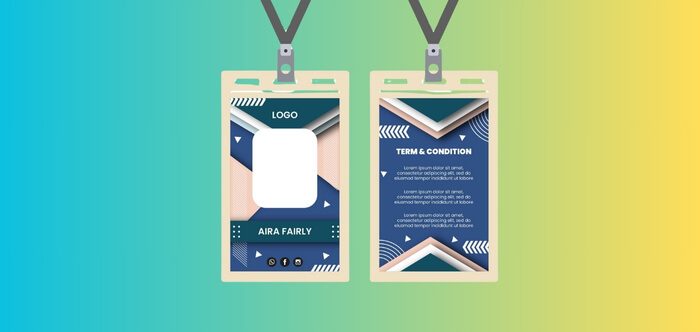Conference badges are essential tools for networking and identification at events, often reflecting the event’s branding and theme. However, a common concern arises: Can you make conference badges for free?
No, the process of creating these badges is not typically free as it involves several elements like design, materials, and printing costs. While some events might offer badges as part of the registration fee, making them completely free of charge is uncommon due to the built-in expenses.
Interested in learning more about the process and how to potentially minimize costs? Stay with us as we explore deeper into the world of conference badges in the rest of this article.
A Quick Summary of Conference Badge Purposes
Conference badges serve a multifaceted role in events and meetings. They’re not just ID tags; they foster networking and enhance security. By displaying names and affiliations, they break the ice, making introductions smoother and more approachable.

In large gatherings, these badges are essential for those who organize conferences internationally. They help in separating attendees, speakers, and staff, streamlining the event management. This clear distinction supports efficient coordination and eases the navigation through various segments of an event.
Additionally, badges are often used as a marketing tool. They’re customizable, offering a space for logos and sponsor names. This subtle branding reinforces recognition and offers additional exposure to sponsors or partners.
Different Types of Conference Badges
Conference badges come in various forms, each tailored to meet the specific needs of different events. From basic name tags to high-tech solutions, the range is diverse. In addition to different types of conferences, different types of badges are also available. Let’s explore the different types of conference badges available.
Paper Badges
Paper badges are cost-effective and widely used for short-term events. They’re easy to print and can be customized with basic information. However, they’re not durable and can easily wear out or get lost. These are ideal for one-day conferences or workshops.
Plastic Badges
Plastic badges offer a more durable option than paper. They can withstand handling and are less prone to damage. These badges often have a professional look and feel. They’re suitable for multi-day conferences or trade shows.
Lanyard Badges
Lanyards with attached badges are popular for their visibility and convenience. They can be worn around the neck, keeping hands free. The lanyard itself can be customized with logos or colors. This type is common in both corporate and casual settings.
Smart Badges
Smart badges incorporate technology for added functionality. They can include QR codes or RFID chips for easy scanning. These badges streamline registration and access control processes. They’re great for large-scale and tech-focused events.
Reusable Badges
Reusable badges are an eco-friendly option. They can be updated for different attendees or events. Though initially more expensive, they save costs in the long run. They’re ideal for organizations hosting regular events.
Magnetic Badges
Magnetic badges offer a secure way to attach without damaging clothing. They’re easy to wear and remove, and they look sleek. However, they can be more expensive than traditional pin-on badges. These are preferred for high-end events or executive meetings.
Can You Make Conference Badges for Free?
No, making conference badges typically isn’t free. The process involves various components such as design, materials, and production, all of which usually incur costs. While some events might include badges in their registration fee, creating them without any cost is not common.

Design Costs
Designing a badge requires creative input, often involving a professional designer. This phase covers layout, color scheme, and branding elements. If done in-house, it could reduce costs, but quality might vary. Outsourcing to a designer ensures professionalism but adds to the expense.
Materials Used
Badges are made from various materials like paper, plastic, or even tech-enhanced components. Higher-quality materials increase durability but also raise costs. Cheaper materials can cut expenses but might not give the desired impression. Balancing cost and quality is key in material selection.
Printing Expenses
Printing involves machinery and labor, both of which cost money. Bulk printing can reduce the cost per badge. However, smaller quantities might be more expensive individually. Advanced features like lamination or special finishes add to the printing costs.
Technology Integration
For tech-enhanced badges like RFID or smart badges, costs rise significantly. These technologies offer added functionalities like tracking or enhanced security. While beneficial for larger or high-end events, they’re costlier than basic options. This technology integration is optional and depends on event needs.
Labor and Time
Creating badges involves labor, from design to distribution. Labor costs vary based on the complexity of the badge and the quantity needed. Time is also a factor; last-minute orders might incur rush fees. Efficient planning can reduce these costs.
Shipping and Handling
If badges are not made onsite, shipping and handling costs apply. Bulk orders might get discounted shipping rates. However, for international events, these costs can be significant. Proper planning can help minimize these expenses.
While creating conference badges for free is not typically possible, understanding these cost factors can help in budgeting and decision-making for your event.
How to Make Conference Badges?
Creating conference badges is a crucial step in organizing a successful event. It requires a blend of creativity, planning, and attention to detail. Here’s a step-by-step guide to help you design and produce effective conference badges.
Step 1: Define Badge Purpose and Audience
Start by understanding the purpose of your badges. Are they for identification, networking, or including technological features like QR codes? Knowing your audience, whether it’s corporate professionals or tech enthusiasts, helps tailor the design and functionality.
Step 2: Choose the Right Material
Select a material that suits your event’s needs and budget. Options range from paper for economical, short-term use to durable plastics for multi-day conferences. Consider environmental factors if opting for reusable or eco-friendly materials.
Step 3: Design the Badge
Designing is a critical step. Ensure the badge displays essential information like name, title, and organization clearly. Incorporate event branding, colors, and logos. Tools like Adobe Illustrator or Canva can be used for designing, or you can hire a professional designer for a more polished look.
Step 4: Decide on Technology Integration
For high-tech events, consider integrating technologies like RFID or NFC for networking and tracking purposes. This step is optional but can enhance the attendee experience significantly in larger or more sophisticated events.
Step 5: Printing and Production
Once the design is finalized, move to printing. If you’re printing in-house, ensure your printer can handle the chosen material and design complexity. For bulk or specialized printing, outsourcing to a professional printing service is advisable.
Step 6: Assemble and Customize
After printing, assemble the badges. This might involve attaching lanyards, holders, or clips. You can further customize badges with additional items like stickers or ribbons for different categories of attendees (like VIPs, speakers, etc.).
Step 7: Distribution and Management
Plan for efficient distribution of the badges at the event. Consider setting up a registration desk for this purpose. Proper management ensures attendees receive their badges promptly, enhancing their event experience.
Consideration While Designing a Conference Badge
Designing a conference badge requires careful consideration to balance functionality and aesthetics. It’s not just about creating an ID, but also enhancing the overall event experience. Here are some key considerations to keep in mind:

- Legibility is Crucial: The badge must display names and affiliations clearly. Choose fonts and sizes that are easy to read from a distance.
- Size Matters: The badge should be large enough to be noticeable, but not so large that it’s cumbersome. Striking the right balance is essential for comfort and visibility.
- Branding is Key: Incorporate the event’s logo and color scheme. This helps reinforce the event’s brand and leaves a lasting impression.
- Material Selection: Choose materials based on the event’s duration and budget. Durability is important for multi-day events, while paper might suffice for shorter ones.
- Incorporate Necessary Information: Besides the name, consider including the attendee’s role or organization. This information aids networking and interaction among participants.
- Security Features: For high-profile events, consider security elements like holograms or QR codes. These features can enhance safety and streamline event management.
- Design for Functionality: If using technology like RFID, ensure the badge design accommodates it efficiently. The design should facilitate, not hinder, the technological functionalities.
A well-designed badge not only serves as a functional tool but also enhances the overall attendee experience.
Conclusion
In our discussion about making conference badges, it’s evident that the process involves more than just printing names on tags. Costs for design, materials, and production are essential considerations, impacting the overall workability and quality of the badges.
Particularly when addressing can you make conference badges for free, the reality points to essential expenses. Accurate planning and execution are vital to avoid missteps in this process, as errors can be costly to rectify.
Conference badge production is an important investment in the success of any event, even though it is not free. It ensures not just identification but also aids in networking, branding, and security, adding significant value to the attendee experience.





